Endurance Events and Lactate Testing
With Emphasis on the Triathlon
17 of 19
The importance of consistency in testing
what you must control
What could affect test results
It is important that the coach and athletes know which factors affect test results. If a coach performs a test on a hot humid afternoon on wet grass after two days of easy workouts, will the results be different if the same test was given on a dry cold windy morning on a cinder track the day after a major competition? The answer is of course it will be different. The next question is "which of these factors affected the results of the test?" The answer is they all did but not in the same way.
You notice I did not say lactate tests in the above paragraphs. Every type of test will be affected by the above factors whether it is a time trial, a heart rate measurement, perceived effort or other measures that coaches use. To win you must test. To test you must be consistent. So to win or excel you should pick the most appropriate tests you can find, that you can control.
The important point is to be consistent from one test to the next. It is impossible to pick the ideal testing environment, but at least the coach and athlete can try to pick a consistent situation for each test. This does not mean you cannot test because the test environment may never be the same. If you do not test, athletes will never reach their potential because they will never get the feedback necessary to improve. To use a Freudian phrase, those who do not test are in denial.
What factors can affect a test?
The following is a series of examples of how various factors affect lactate tests. These are meant to show the coach and athlete 1) how different testing environments can affect a result and 2) the value of being consistent
Sport specificity of the test
Test results are only valid for the sport discipline practiced during the test. So, test results from a cycling test cannot be used to evaluate the athlete's swimming or running profile. One should never try to extrapolate test results from one sport discipline to the other. Each sport uses different muscles and requires completely different technique.
Example 1A - An elite swimmer was tested over a period of 4 years in running
and in swimming. No difference in endurance capacity (maximal VO2 uptake) of the athlete was seen in the
run test while dramatic fluctuations of the endurance capacity(maximal VO2 uptake) were observed in the
swim test. The changes in the swim test results corresponded with performance changes in swimming.
(Lower maximal VO2 uptake correlated with slower performances in competition in the respective periods.)
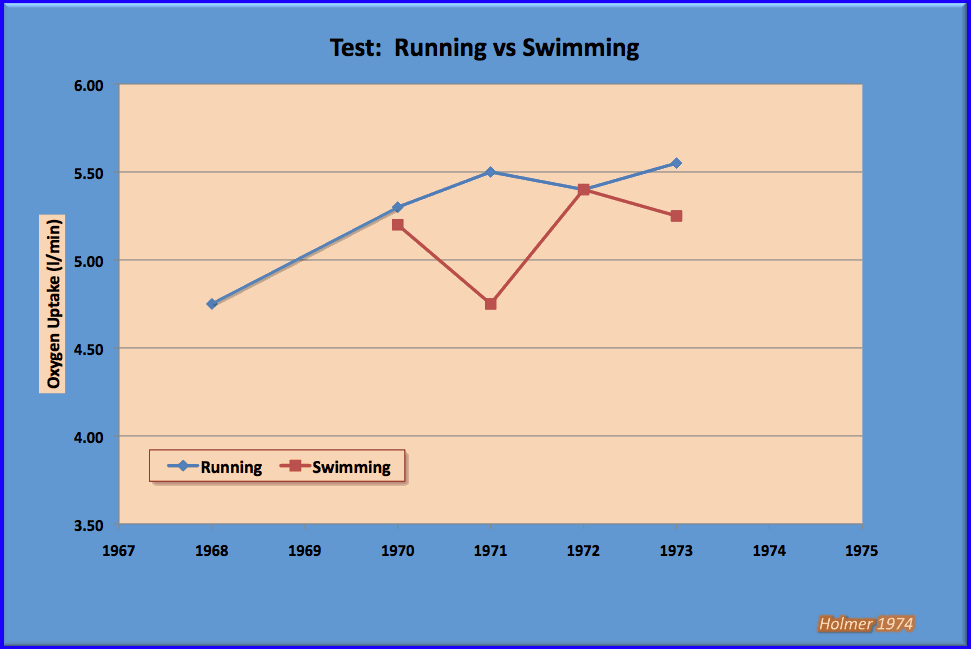
Example 1B - Another study showed that the maximal oxygen uptake (VO2 max) of runners tested on a cycle-ergometer was consistently below the values observed during their treadmill test.
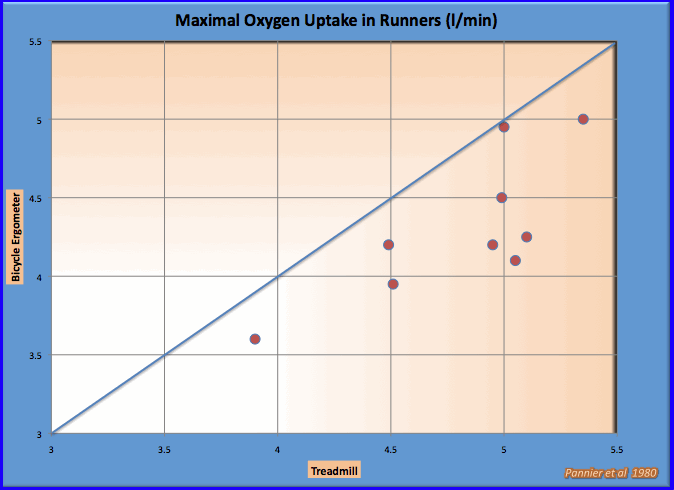
Lab versus field tests
If you really need a 100% comparable test outcome, then you are forced to do a lab test in order to avoid a changing environment (temperature, humidity, etc) and other interactions that may affect field test results. Also more complicated measurements or academic research designs may require testing in a lab.
However, if a coach or athlete wants information for a training program, they should test as near as possible to the athlete's training environment. Changing weather and other fluctuations over seasons will affect the performance potential of the athlete but are inherent in the training situation. These factors must be captured in field tests since they need to be taken into account for optimizing the training process. On the other hand the comparability of field test results is less exact due to these changing conditions.
Field tests are clearly imperative and are much more valuable than lab tests for providing training information.
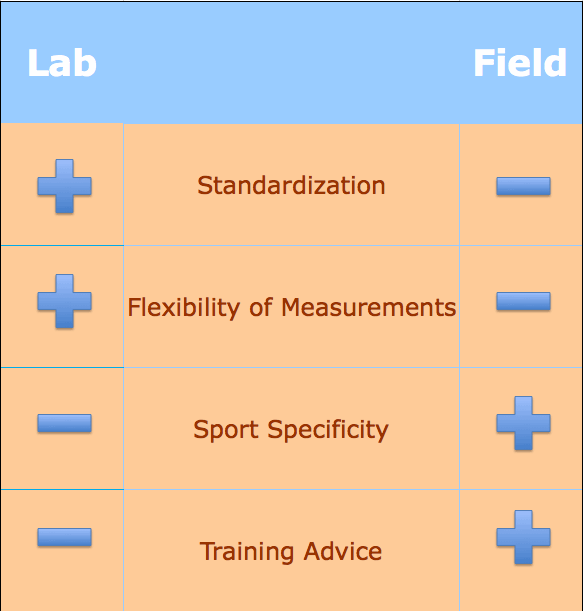
Influence of test procedure on lactate test results
We know that the test procedure has an impact on the results of a lactate test. The accumulation of lactate will happen at an earlier stage in a multiple step test when the rest between the steps is reduced or when the duration of the steps is increased. Oxygen uptake on the other hand is unaffected by changes in the duration of the steps and the rest between the steps.
Example 2A. - In the following experiment several athletes completed three step tests on a treadmill using 3, 5 and 7 minute steps. At every speed, lactate levels are higher after the 7 minute step. For the 3 and 5 minute steps the lactate has not come to an equilibrium at the end of the step so the readings are misleading. Lactate readings are affected by the duration of the step and the increase in effort between steps. Smaller changes in pace or effort between steps will require less time for lactate to come into equilibrium.
Notice that there are wide differences in the lactate at higher intensities between the three stage
lengths but there are almost no differences between the VO2 measures for the same stages.
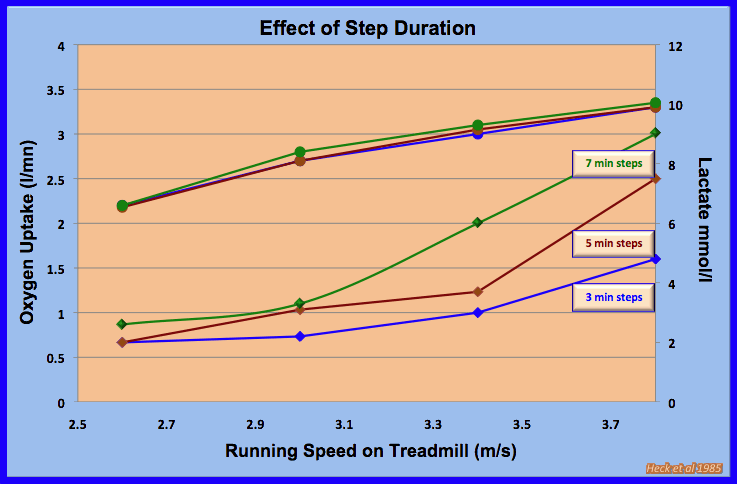
Example 2B. - In a different experiment several athletes completed three step
tests on a treadmill but varied the amount of rest between each step. Notice again that the VO2
measurements are unaffected by the change in rest.
.
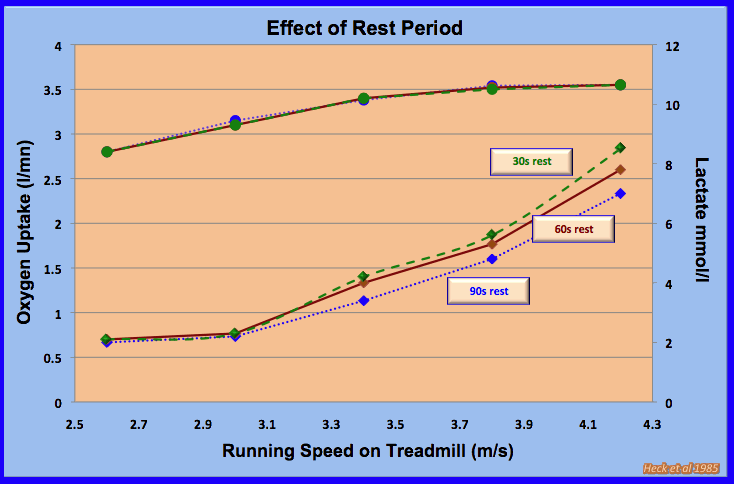
Continue on to Module 18 on consistency in testing - what else to consider
Module 18 of 19- the importance of consistency in testing - what else to consider
